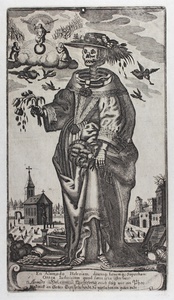| Method | Copper engraving |
| Artist | Gerhardt Altzenbach |
| Published | c. 1650 |
| Dimensions | Image 238 x 132 mm, Plate 240 x 135 mm, Sheet 345 x 208 mm |
| Notes |
A supremely characterful memento mori engraving by Altzenbach, depicting a skeleton dressed in the finery of a wealthy seventeenth century lady. She stands full-length, wearing a lace-trimmed dress and a broad-brimmed hat garlanded with feathers and flowers. She gathers the folds of her dress with her left arm, an ostrich-feather fan clutched in her bony hand. Her right hand, outstretched, delicately holds a bouquet of wilted flowers, their petals falling as she gestures. At her feet are symbols of her life of wealth and vanity - golden urns, a purse of coins, cosmetic brushes, and a mirror. The skies above her set the scene. Christ pantokrator rests atop a globe, while the angelic hosts of heaven issue forth, sounding the trumpets for the apocalypse. In the churchyard of a ruined city in the background, the dead rise from their graves to face their Judgement. Below the image and enclosed in a scrolled cartouche are two lines of text in Latin, and a translation in German blackletter: "En Alamodo Helenam, ditemque Levemque Superbam: Ossea Iudicicium quod feret ista strues?" (Behold Helen in the latest fashion, wealthy, fickle, proud: What Judgement will this pile of bones endure?) "O alamodo Helenna leichtfertig reich stoltz wie ein Phow, Gedenkt an Gottes Gericht behendt, so wirstu han ein gutes Endt." (O Helen à la mode, fashionable, rich, and proud as a peacock, Consider quickly God's Judgement, and you shall make yourself a good End.) The inscription equates the skeletal woman with the famous Helen, Queen of Sparta, and causus belli for the Greek siege of Troy. Although the engraver's name is scratched from the plate, a matching plate signed by Altzenbach features a male skeleton in similarly rich garb and is entitled 'Munde Paris' - the 'Wordly Paris' - an appropriate mate for Helen à la mode. Though both were in many ways the unwitting pawns in a much larger divine game, the actions of Paris and Helen have traditionally made them the ideal analogues for artistic and literary examinations of worldly vanity and its consequences. For Altzenbach's seventeenth century audience, the use of these classical archetypes was loaded with extra meaning, adding a much greater level of nuance, and warning, to the overt depictions of vanity in the scene. Gerhardt Altzenbach (c.1590-c.1672) was a German engraver, bookseller, and art dealer, active in Cologne. Styling himself a Heiligentrucker - a printer of religious works - he is best known for his many memento mori and vanitas scenes. His first known work, published in 1612, was a broadside detailing the relics of Aachen, Trier, and Cologne. His son of the same name was also an engraver, and differentiating between works by the two men is difficult. Condition: Superb dark impression with full margins. Minor ink staining from plate to inscription space. Engraver's name scratched out on plate, as issued. Blank on verso. Framed in an antique frame. |
| Framing | framed |
| Price | £2,500.00 |
| Stock ID | 50232 |

